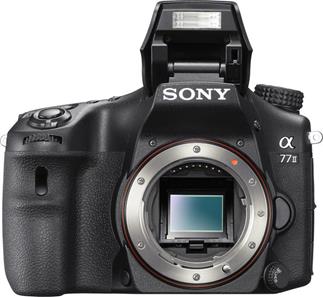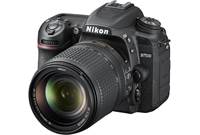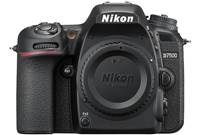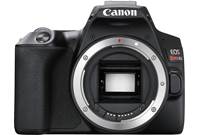About the Sony a77 II (no lens included)

A photographer's dream

The Sony Alpha 77 M2 has a built-in flash to help light your subject.
A photographer's dream
Sony's a77 II is ideal for shooting sharp, clear photos at a reasonable price point. The camera is built around a large, sensitive 23.5 X 15.6mm CMOS image sensor for superior low-noise and low-light image performance. The SteadyShot INSIDE™ image stabilization built into the camera body makes sure you can shoot vibration-free images through any compatible lens. Built-in Wi-Fi makes it easy to upload and share your photos and videos with friends.
Improved 79-point autofocus
The original a77 had a very nice 19-point autofocus mode. The a77 II has an astonishing 79 points of focus with 15 cross-type sensors, allowing maximum precision when you're shooting fast and furious in the field. The revamped phase-detection focusing system has dramatically improved low-light response, so it can track a moving subject even when it might be difficult to see with the naked eye.
Ultra-sensitive imaging
The Sony BIONZ™ X image processor built into the chassis is capable of producing accurate, low noise images on the fly. The camera's ISO sensitivity has been expanded to a range of 100-25,600, so it can produce crisp, clear images at any speed and in most lighting conditions. When you're framing the shot, you'll know exactly how your subject looks in real time as well — both the viewfinder (2,359,000 dots) and tilting viewscreen (1,228,800 dots) offer flexible, high-resolution framing assistance.
Choose your own lens
The A77 M2 body is compatible with any of Sony's A-mount lenses. That means you can still use your existing lenses if you're upgrading from a similar Sony product. You can also expand your lens options as needed — Sony's A-mount lenses range from macro lenses well-suited for close-up photography all the way up to super telephoto lenses that can capture a subject hundreds of yards away.
Product highlights:
- 24.3-megapixel effective recording
- APS-C size HD Exmor™ CMOS image sensor (23.5 X 15.6 mm) for superior low-noise and low-light image performance
- built-in Wi-Fi® lets you upload and share photos quickly and easily
- 1080/60p HD video mode with full-time autofocus
- built-in sensor-shift SteadyShot INSIDE™ image stabilization (provides image stabilization with all attached lenses)
- Sony BIONZ™ X image processor for accurate, low noise images and responsive shooting
- high-res 3" three-axis articulated LCD screen (1,228,800 dots) with live view for composing photos and movies on-screen in real-time
- screen tilts, rotates, and swivels for perfect monitoring from any angle
- OLED electronic viewfinder (2,359,000 dots) with diopter adjustment
- 79-point auto-focus with 15 cross-type sensors to maximize precision during high-speed focusing
- 3D Sweep Panorama mode: sweep across the panorama, and the camera captures "right-eye" and "left-eye" versions of the image. 3D TV and 3D glasses required to view images in 3D
- auto High Dynamic Range (HDR) mode takes three exposures in rapid succession and combines them to capture increased shadow and highlight details
- built-in auto pop-up flash with flash compensation
- powered accessory shoe lets you add compatible external flashes
- Sony A-type bayonet mount
- accepts Memory Stick® PRO Duo™ or SD, SDHC, or SDXC memory cards
- warranty: 1 year
Exposure Modes and Controls:
- continuous shooting mode: up to 8 frames per second (12 fps in Continuous Priority AE mode)
- shutter speed range: 30-1/8,000 seconds, bulb
- sensitivity or ISO (film speed equivalent) range: 100-25,600
- program auto, shutter-priority, aperture-priority, manual, auto-advanced, scene, and fully automatic exposure modes
- preset scene modes for accurately exposed images in various shooting environments
Connections and Dimensions:
- high-speed USB interface (cable included)
- mini HDMI output for sharing images on a compatible HDTV (cable not included)
- input for optional external microphone
- 5-5/8"W x 4-1/8"H x 3-1/4"D (without lens)
- weight (body only): 25.6 oz.
Supplied Accessories:
- rechargeable NP-FM500H lithium ion battery
- battery charger
- adjustable shoulder strap
- USB cable
- body cap
- MFR # ILCA77M2
What's in the box:
Sony a77 II (no lens included) owner's manual
- Digital camera body (black)
- Body cap (installed)
- Hot shoe cover (installed)
- NP-FM500H Lithium-Ion rechargeable battery (7.2V 1600mAh 11.5Wh)
- BC-VM10 battery charger (8.4V 750mA)
- 23.5" USB cable (Type A USB on one end and Micro USB on other end)
- Neck Strap
- Instruction Manual (English)
- Instruction Manual (French)
- Limited Warranty sheet
- Wi-Fi Connection/One-Touch (NFC) Guide (Eng/Fren)
- Product registration sheet (US/Can)
- Lenses & Accessories brochure
- To Catch Subjects Moving Even Faster sheet
Customer reviews for Sony a77 II (no lens included)
Loading...
Loading reviews...
Average review:
5.0 out of 5 starsThanks for submitting your review
Customer photos
This review was collected as part of a promotion
Pros:
Cons:
More details on the Sony a77 II (no lens included)

Features & specs
| General | ||
|---|---|---|
| LCD Screen Size | 3" | |
| Adjustable-angle LCD | Yes | |
| Wi-Fi | Built-in | |
| GPS-enabled | No | |
| Lens 35mm Equivalent | None | |
| Optical Zoom | N/A | |
| Digital Zoom | 8x | |
| Filter Diameter | N/A | |
| Manual Focusing | Yes | |
| Manual Exposure | Yes | |
| Built-in Flash | Yes | |
| HDMI Output | Micro | |
| Memory | ||
| Internal Memory | None | |
| Memory Stick | PRO Duo, PRO-HG Duo | |
| CFexpress Cards | No | |
| CompactFlash Cards | No | |
| SD Cards | SD, SDHC, SDXC | |
| XQD Cards | No | |
| Image | ||
| Sensor Size | APS-C | |
| Megapixels | 24.3 | |
| Image Stabilization | In-body | |
| Highest Resolution | 6000 x 4000 | |
| 4K Video | No | |
| Video Resolution | 1920 x 1080 | |
| Dimensions | ||
| Width (inches) | 5-7/8 | |
| Height (inches) | 4-1/8 | |
| Depth (inches) | 3-7/16 | |
| Weight With Battery (ounces) | 25.6 | |
| Warranty | ||
| Parts Warranty | 1 Year | |
| Labor Warranty | 1 Year | |
Product Research
Built-in Wi-Fi
Play And Print Functions
Battery Information
Software
Recording Features
Overview: The Sony α77 II (ILCA-77M2) Alpha series camera kit contains the α77 II camera body, along with a rechargeable battery, adjustable neck strap, and USB cable. The α77 II has an APS-C HD CMOS image sensor with 24.3 megapixels, and is compatible with Sony A-mount lenses. No lenses are included with this "body only" kit.
3" Tiltable LCD Screen: The α77 II uses a 3" Xtra Fine LCD screen with 1,228,800 dots and 100% coverage. You can tilt the LCD up approximately 150° for low angle shots or self portraits, or tilt down approximately 180° for high angle photography. You can also rotate the LCD 180° clockwise and 90° counterclockwise. The brightness of the LCD monitor can be manually adjusted in 5 steps from -2 to +2, or set to Auto or Sunny Weather.
0.5" OLED Electronic Viewfinder: The 0.5" high contrast Tru-Finder OLED electronic color viewfinder has 2.359-million dots, and provides approximately 100% field of view. You can adjust the brightness in 5 steps. The built-in diopter lets you adjust the viewfinder image to your individual eyesight. You can set the camera to switch between the LCD screen and viewfinder automatically when you look into the EVF, or choose one or the other via the Finder/Monitor button on the top of the camera.
Display Options: You can choose how much information appears in the viewfinder and LCD monitor. There are five options each for the LCD screen and Viewfinder: Graphic Display, Display All Info, No Display Info, Level, and Histogram. There's also a "For Viewfinder" display option which shows multiple camera settings at once on the LCD screen that you can use when shooting with the viewfinder.
Live View: The α77 II's Live View lets you use the LCD screen and Electronic Viewfinder to frame your photos as you shoot. When the Live View display is set to "Setting Effect On", the LCD or viewfinder will provide an accurate preview of your photo, including the white balance, exposure compensation, creative style or picture effect. With the "Setting Effect Off", you can check the image composition without the effects of the exposure settings.
Image Sensor: The α77 II features the Exmor APS-C HD CMOS image sensor (23.5 x 15.6mm). It has approximately 24.7-million total pixels and 24.3-million effective pixels.
Still Image Recording Formats: The α77 II can shoot still images in JPEG file format in Standard, Fine, and Extra Fine compression rates. You can choose to shoot in 3:2 or 16:9 aspect ratio, and in large, medium, and small image sizes. You can also record still images using the RAW format, which is uncompressed with no processing performed in the camera. RAW images must be transferred to a computer for processing, editing, and printing using the downloadable Image Data Converter software. You can select the following image sizes:
| Aspect Ratio/Size | Recording Pixels |
|---|---|
| 3:2 Large | 24M: 6000 x 4000 |
| 3:2 Medium | 12M: 4240 x 2832 |
| 3:2 Small | 6.0M: 3008 x 2000 |
| 16:9 Large | 20M: 6000 x 3376 |
| 16:9 Medium | 10M: 4240 x 2400 |
| 16:9 Small | 5.1M: 3008 x 1688 |
| 3:2 RAW (L) | 24M: 6000 x 4000 |
| 16:9 RAW (L) | 20M: 6000 x 3376 |
Panorama Photos: The Panorama mode lets you record panoramic images by holding down the shutter button as you pan across the scene. Panoramic photos can be taken in several different resolution settings:
- Standard:
- Vertical: 3872 x 2160
- Horizontal: 8192 x 1856
- Wide:
- Vertical: 5536 x 2160
- Horizontal: 12416 x 1856
Movie Recording Formats: The α77 II can record moving images in AVCHD Ver. 2.0 format (MPEG-4 AVC/H.264 with Dolby Digital 2ch audio) or MP4 (MPEG-4/H.264 with 2-channel AAC audio). You can choose from the following file formats and bit rates:
| File Format | Average Bit Rate | Resolution |
|---|---|---|
| AVCHD 60i 24M (FX) | 24 Mbps | 1920 x 1080 (60i) |
| AVCHD 60i 17M (FH) | 17 Mbps | 1920 x 1080 (60i) |
| AVCHD 60p 28M (PS) | 28 Mbps | 1920 x 1080 (60p) |
| AVCHD 24p 24M (FX) | 24 Mbps | 1920 x 1080 (24p) |
| AVCHD 24p 17M (FH) | 17 Mbps | 1920 x 1080 (24p) |
| MP4 1440 x 1080 12M | 12 Mbps | 1440 x 1080 (30fps) |
| MP4 VGA 3M | 3 Mbps | 640 x 480 (30fps) |
Dual Media Options: The α77 II camera accepts two types of media for capturing still images: Memory Stick PRO Duo, Memory Stick PRO-HG Duo, and Memory Stick XC-HG Duo, plus SD, SDHC, and SDXC Memory Cards. The maximum number of images that can be recorded on a memory card formatted with this camera varies slightly between the two types of media.
Clear Image Zoom: Clear Image Zoom, powered by Sony's By Pixel Super Resolution Technology, increases the effective focal length of the lens by up to 1.4x (Medium images) or 2x (Small images) by digitally magnifying the center of the image. Combined with the camera's Digital Zoom and Smart Zoom, you can increase magnification up to 8x over the lens' maximum focal length.
Focus Modes: The α77 II's Fast Intelligent auto focus system combines the high-speed BIONZ X image processor and improved algorithms with optimized image sensor read-out speed to provide ultra-fast auto focusing. You can choose from the following Focus Modes using the rotary dial on the front panel of the camera:
- Single-shot AF (S): The camera focuses and the focus is locked when you press the shutter button halfway down. Recommended for use with motionless subjects.
- Automatic AF (A): The camera switches between Single-shot and Continuous AF depending upon the movement of the subject.
- Continuous AF (C): The camera continues to focus when you press and hold the shutter button halfway down. Recommended for use when the subject is in motion.
- Manual Focus (MF): When it is difficult to get the proper focus in auto focus mode, you can adjust the focus manually. This mode allows you to set the distance of a subject by rotating the focusing ring to achieve a sharp focus.
AF (Auto focus) Area: You can select between 5 settings:
- Wide: The camera focuses automatically on a subject in all ranges of the image.
- Zone: You can select a zone (consisting of 9 focus areas) on the monitor on which to focus.
- Center: The camera uses the AF area located in the center area exclusively.
- Flexible Spot: You can change the size of and move the focusing area in order to focus on a small subject or narrow area.
- Expand Flexible Spot: If you can't focus on a single selected point, the expanded flexible spot uses the eight focus points around the flexible spot as the second priority area to achieve focus.
Eye AF: The new Eye AF function can be assigned to a customizable button. When Eye AF is selected, the camera focuses on a person's eyes for extremely sharp focusing of the face.
Face Detection/Smile Shutter: The camera can detect human faces, and adjusts the focus, exposure, performs image processing and adjusts flash settings for best results. Faces can be registered, and priority given to those faces over others in the frame. Up to 8 faces can be detected and/or registered. When the Smile Shutter feature is enabled, the camera will automatically release the shutter when a slight, normal, or big smile is detected.
Focus Lock: If a subject is off-center and outside of the AF area, you can lock the focus of the camera.
AF Illuminator: When you press the shutter button halfway down a red illuminator is emitted until the focus is locked. Under dark lighting conditions or when you shoot a low contrast subject, the AF illuminator allows the camera to focus more easily on the subject.
Drive Modes: The camera offers the following shooting modes:
- Single Shooting: Default setting for standard picture taking.
- Continuous Shooting: At full resolution, the camera can record continuously up to 8 frames per second at the high speed setting, and about 3 fps at low speed.
- Continuous Priority AE: By fixing the aperture value when shooting the first image, you can shoot images continuously at approximately 12 frames per second.
- Self-Timer: You can set the camera to three different self-timers:
- 10 Second: After you press the shutter button, the shutter will be released about 10 seconds later. This is convenient when the photographer wants to appear in a photo.
- 2 Second: After you press the shutter button, the shutter will be released about 2 seconds later. This is convenient to reduce camera-shake.
- 10 Seconds/3 or 5 Images: The camera records 3 or 5 images continuously after a 10 second delay. You can choose the best shot from the shots taken.
- Bracket Shooting: The camera is capable of shooting
multiple images, each with a different setting. You can choose from the
following Bracket options:
- Continuous Bracket: Shoot 3 or 5 images, each with different degrees of brightness (0.3EV, 0.5EV, 0.7EV, 1.0EV, 2.0EV or 3.0EV). The images are taken as you press and hold the shutter button.
- Single Bracket: Same as Continuous Bracket above, except that the shutter button is pressed for each image.
- WB Bracket: The camera records three images, each with different color tones, according to the selected settings of white balance, color temperature, and color filter. You can select Low (small changes in white balance) or High (large changes in white balance).
- DRO Bracket: The camera records three images, each with different degree of D-Range Optimizer. You can select Low (small changes in DRO) or High (large changes in DRO).
Shooting Modes: The top-mounted Mode Dial lets you select from the following shooting modes:
- Auto: In the menu, you can choose which of the following are
desired when the Mode Dial is set to Auto:
- iAuto (Intelligent Auto): This mode allows easy shooting with settings adjusted automatically.
- iAuto+ (Superior Auto): The camera recognizes and evaluates the shooting condition and sets the appropriate settings automatically. The camera saves one appropriate image by combining or separating images as necessary.
- Program Auto: For shooting with the exposure adjusted automatically (both the shutter speed and the aperture value), while allowing you to adjust other settings manually.
- Aperture Priority: This mode allows you to shoot after adjusting the aperture value manually, letting the camera set the appropriate shutter speed. This mode gives you greater control over the depth of field.
- Shutter Speed Priority: This mode allows you to shoot after adjusting the shutter speed manually, letting the camera set the appropriate aperture. With a high shutter speed, the moving subject appears as if it is frozen on the image. With a slow shutter speed, the moving subject appears as if it were flowing.
- Manual Exposure: This mode allows you to shoot after adjusting the exposure (shutter speed and aperture) manually.
- Memory Recall (1, 2, 3): You can register often-used camera settings (including Shooting Mode, Aperture, Shutter speed) in one of three memory positions on the Mode Dial for easy recall.
- Movies: You can record movies in Full HD or standard definition in 16:9 or 4:3 aspect ratio. When selected on the Mode Dial, you can select the desired movie settings, including Program Auto, Aperture Priority, Shutter Priority, and Manual Exposure.
- Continuous Priority AE: This mode lets you shoot continuously at high speeds (up to 12 fps) by fixing the aperture value at the first image.
- Sweep Panorama: Shoot expansive scenery or high-rise buildings with dynamic composition.
- Scene Selection: You can select an appropriate mode for the subject or the shooting conditions to allow you to shoot the image with a suitable setting for the subject: Portrait, Sports Action, Macro, Landscape, Sunset, Night Scene, Hand-held Twilight, and Night Portrait.
Picture Effect: In Intelligent Auto or Superior Auto mode, you can select Picture Effect to get one the following effect filters to achieve more impressive and artistic expression: Toy Camera, Pop Color, Posterization (color), Posterization (B/W), Retro Photo, Soft High-key, Partial Color (Red, Green, Blue, or Yellow), High Contrast Mono, Soft Focus, HDR Painting, Rich-tone Mono, Miniature, Watercolor, and Illustration.
Creative Style: The Creative Style function lets you select the desired image processing. You can adjust exposure (shutter speed and aperture) as you like with Creative Style. You can choose from: Standard, Vivid, Neutral, Clear, Deep, Light, Portrait, Landscape, Sunset, Night Scene, Autumn Leaves, Black & White, or Sepia. You can also adjust Contrast, Saturation, and Sharpness.
Exposure Compensation: Exposure compensation is used to alter the camera's standard exposure setting. You can make the image look lighter (increased exposure) or darker (decreased exposure). The exposure compensation amount can be set up to +/-5.0 EV in 1/3-step or 1/2-step increments. When shooting movies, the exposure can be adjusted in a range of +/-2.0 EV. You can adjust the Exposure Compensation using the dedicated button on the top of the camera or in the menu.
AE Lock: You can fix the exposure before deciding on the composition when taking a picture. This is effective when the metering object and focusing object are different or when you want to shoot continuously while keep the same exposure value.
Metering Mode: A 1200-zone evaluative sensing system provides multi-pattern measuring for superior exposure control accuracy in a wide range of lighting conditions. You can select the method for measuring the brightness of a subject from the following three methods:
- Multi: This method uses the whole screen divided into 1200 zones to measure light.
- Center: While emphasizing the central area of the screen, this method measure the average brightness of the entire screen.
- Spot: This method measure light only in the spot metering circle in the center of the frame.
White Balance: You can adjust the color tones according to the lighting conditions. You can choose from the following WB options: Auto WB, Daylight, Shade, Cloudy, Incandescent, Fluorescent (Warm White), Fluorescent (Cool White), Fluorescent (Day White), Fluorescent (Daylight), Flash, Color Temperature/Color Filter, and Custom (1/2/3).
Color Temperature/Color Filter: You can adjust the white balance further by selecting Color Temperature or Color Filter in the Custom White Balance option. With Color Temperature, the higher the number, the more reddish the image, and the lower the number, the more bluish the image. Color Filter achieves the effect of Color Compensation filters for photography. Based on the set color temperature as the standard, the color can be compensated to Green (G) or Magenta (M).
ISO Settings: ISO is a unit of measurement of sensitivity to light. The larger the number, the higher the sensitivity. The camera's ISO can be set manually or automatically, depending upon the exposure mode. The manual ISO range is 50 to 25600 in 1/3EV increments.
Multi-Interface Shoe: The α77 II does not have a built-in flash, but is equipped with the Multi-Interface Shoe, allowing you to use an external flash, such as the HVL-F20M, HVL-F43M, or HVL-F60M. The ECM-XYST1M stereo microphone is also compatible.
Flash Features: When an optional external flash is attached, the camera offers several Flash Modes: Autoflash, Fill-flash, Slow Sync, Rear Sync, and Wireless. You can adjust the amount of flash light in a range of -3.0 EV to +3.0 EV with the Flash Compensation feature.
Built-in Wi-Fi
Wi-Fi Overview: The Sony α77 II has built-in Wi-Fi so you can interface the camera with your smartphone or Wi-Fi-enabled laptop computer and wirelessly perform various shooting and playback functions. The camera also supports NFC (near field communication).
PlayMemories Mobile: To interface with the Sony α77 II, your smartphone must have the PlayMemories Mobile application. The app is compatible with iPhone, iPad, and iPod touch, and requires iOS 4.3 or later. It is also compatible with Android smartphones and tablets with the Android 2.3 - 4.4 operating environment.
NFC (Near Field Communication): By touching an NFC-enabled Android smartphone or tablet to the "N" mark on the right side of the camera, the smartphone will be connected automatically via Wi-Fi, and the PlayMemories Mobile app will be launched. The two devices must touch for approximately 1-2 seconds to make the connection. NFC One-touch Sharing allows you to directly send single images from the camera to the smartphone.
Wi-Fi Functions: The following wireless functions can be performed with the α77 II:
- Control with Smartphone: You can use a smartphone as a remote controller for the camera. Still images shot via remote control are automatically sent to the smartphone's memory. You can also change some of the camera's settings, including EV, Self-Timer, and Review Check.
- Send to Smartphone: You can transfer still images to a smartphone for viewing. Images can be transferred in its original image size, or resized to 2M or VGA. RAW images are converted to JPEG format before being transferred.
- Send to Computer: You can transfer images stored on the camera's memory card to a computer connected to a wireless access point or wireless broadband router in order to easily make backup copies.
- View on TV: Images can be viewed on a network-enabled TV. While connected, you can playback images in a slideshow. You can choose from a short or long interval between slides, and select HD or 4K playback. Some BRAVIA TVs have special effects which can be selected for a slideshow.
Play And Print Functions
Playback Screen: You can view your photos back as a single image on the LCD monitor, as an Index or as a Slide Show. During Image Index view mode, you can view 9 (3 x 3) or 25 (5 x 5) images at once.
Auto Review: After an image is recorded, you can have the camera automatically display it on the LCD monitor for two, five or 10 seconds. You can also turn off auto review.
Image Rotation: Vertical shots can be rotated automatically so that they are displayed upright during playback. This can be done manually or automatically.
Slide Show: You can automatically play back still images continuously in a slide show. You can set the interval to 1, 3, 5, 10, or 30 seconds.
View Mode: There are four View Modes to choose from for playing back images and movies: Date View, Folder View (Still), Folder View (MP4), and AVCHD View.
D-Range Optimizer/Auto HDR: The camera allows you to correct the brightness and contrast of an image automatically, using the D-Range Optimizer (DRO) and Auto High Dynamic Range functions. The DRO optimizes the gradations of a recorded image in each area of the image; you select the optimal level from Lv1 (weak) and Lv5 (strong). When Auto HDR is selected, the camera shoots three images with different exposures, then overlays them to create one image with the correct exposure and an overlaid image.
4K Still Image Playback: The α77 II can output images in 4K resolution to an HDMI-connected TV that supports 4K. The 4K playback function can be selected in the Playback Menu only when the camera is connected to a 4K-compatible TV via HDMI or Wi-Fi.
BRAVIA Sync: When connecting the camera to a Sony TV with BRAVIA Sync via HDMI, you can control the camera with the TV's remote control.
Protect Images: You can protect all images on your memory card or select only certain images to be protected from accidental erasure.
Printing Options: The camera offers the following printing options.
- DPOF Compatible: Using the camera, you can specify the images and the number of images to print before you print images at a photo-shop or with your printer.
- Memory Card: You can print images with a Memory Stick or SD card compliant printer.
- Computer: You can copy images to a computer using the available downloadable software and print the images.
Battery Information
InfoLithium Battery: The α77 II is powered by the NP-FM500 InfoLithium battery. The battery communicates data to the camera, so that the percentage of battery power remaining can be displayed. The battery life specs are as follows:
| Function | Battery Life | Number of Images | |
|---|---|---|---|
| Shooting Still Images | LCD | Approx. 240 min | Approx. 480 images |
| Viewfinder | Approx. 205 min | Approx. 410 images | |
| Viewing Still Images | LCD | Approx. 270 min | Approx. 5400 images |
| Viewfinder | Approx. 320 min | Approx. 6400 images | |
| Recording Movies (Typical) | LCD | Approx. 120 min | --- |
| Viewfinder | Approx. 110 min | --- | |
| Recording Movies (Continuous) | LCD | Approx. 175 min | --- |
| Viewfinder | --- | ||
Charging: The NP-FM500 InfoLithium battery requires approximately 175 minutes to reach a full charge, using the supplied BC-VM10A battery charger.
Power Save: You can set different time intervals for the camera to switch to Power Save mode. You can set the interval to 10 seconds, 1 minute, 2 minutes, 5 minutes, or 30 minutes. Once the camera goes into Power Save mode, you can return to the shooting mode by pressing the shutter button halfway.
Software
Downloadable Software: The α77 II does not include software in the box. Instead, Sony offers software for Windows- and Mac-compatible computers for importing still images and movies recorded with the camera to your computer. You can download the software to your computer using the appropriate URL provided in the supplied Instruction Manual. The following downloadable software is compatible with the camera:
- PlayMemories Home: With PlayMemories Home, you can view your images, and use various convenient features to enhance the images you have shot. PlayMemories Home is required for importing XAVC S and AVCHD movies to your computer. PlayMemories Home is compatible with Windows 10, Windows 8.1, Windows 7 (SP1), and Mac OS X v10.10-10.11, macOS 10.12-10.13 operating systems.
- Imaging Edge: Imaging Edge (Remote/Viewer/Edit) software can be used for browsing images (creating time-lapse movies, filtering images by applying ratings), adjusting images (edit and adjusting for brightness, color, and tone), remote shooting, and saving images recorded in RAW format and converting them to JPEG or TIFF format. Imaging Edge is compatible with Windows 10, Windows 8.1, Windows 7 (SP1), and macOS 10.12-10.14.
Loading...
Loading accessories...
Customer Q&A
Loading...
Loading articles...














I've been a Sony/Minolta user for years and this is the best I've had so far. I've only scraped the surface on all of the features, but the general use in low and regular lighting has been fantastic.
Becky S from Manassas, VA